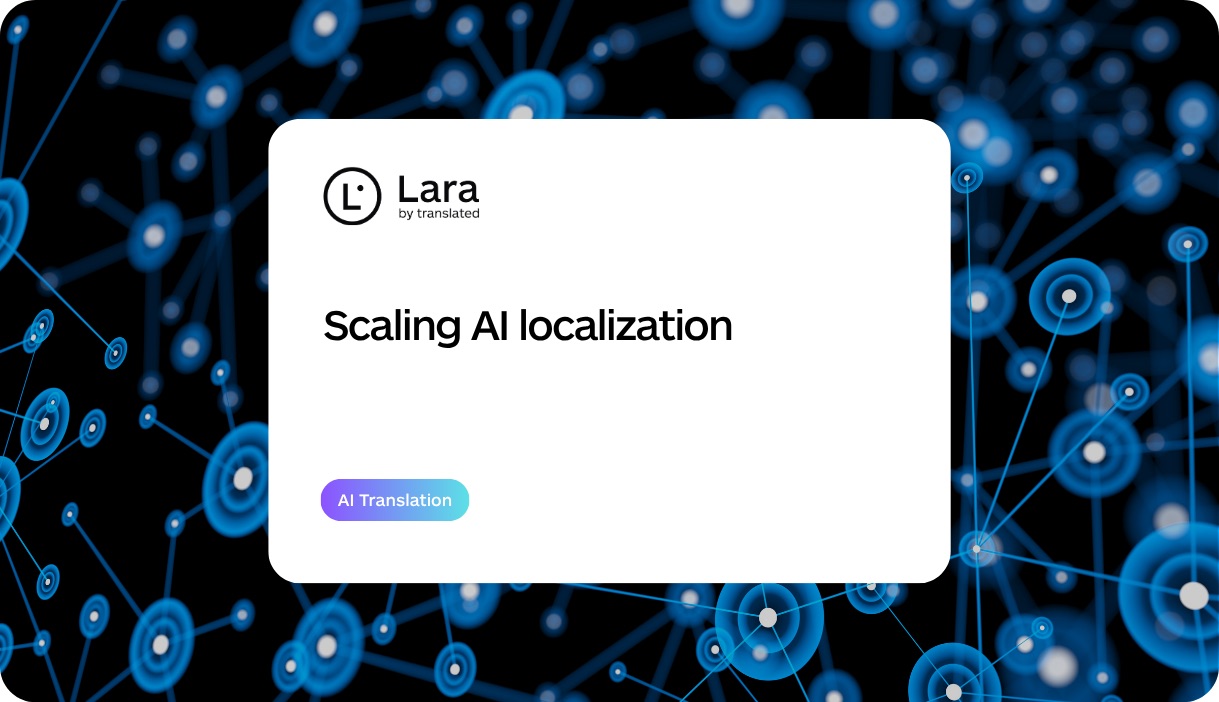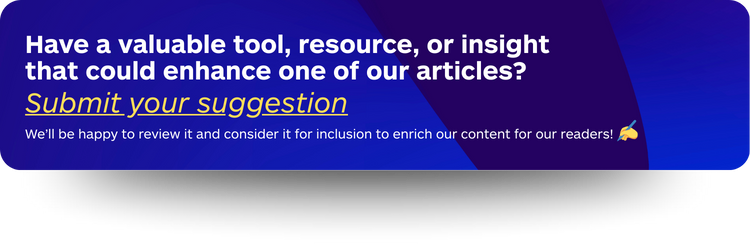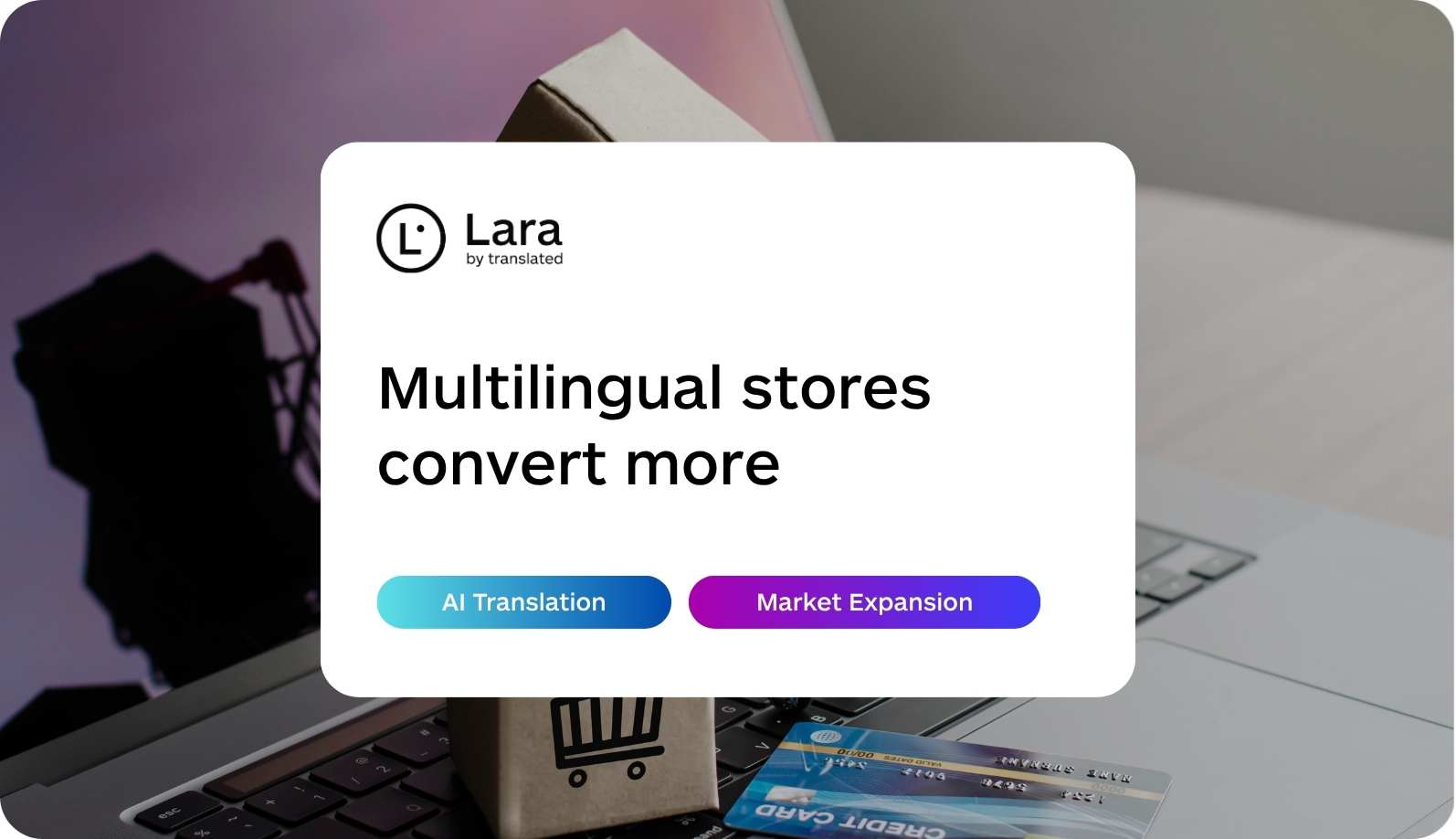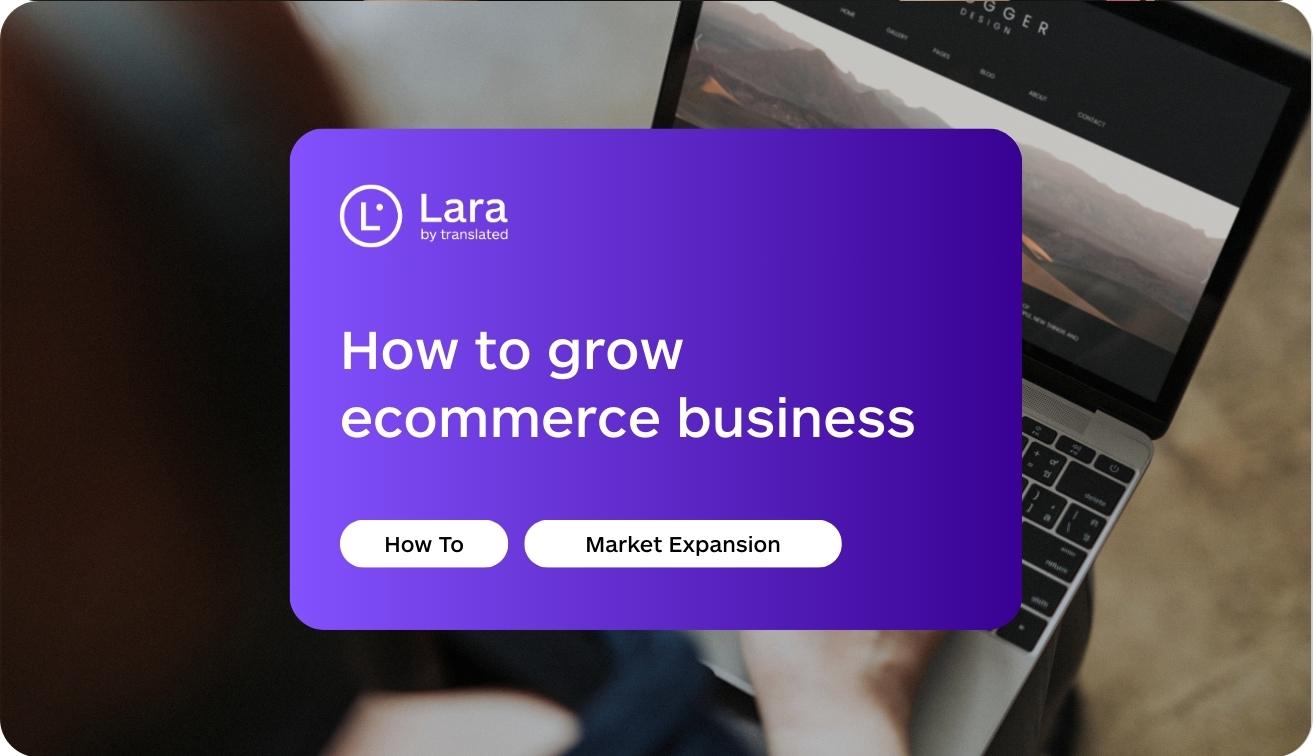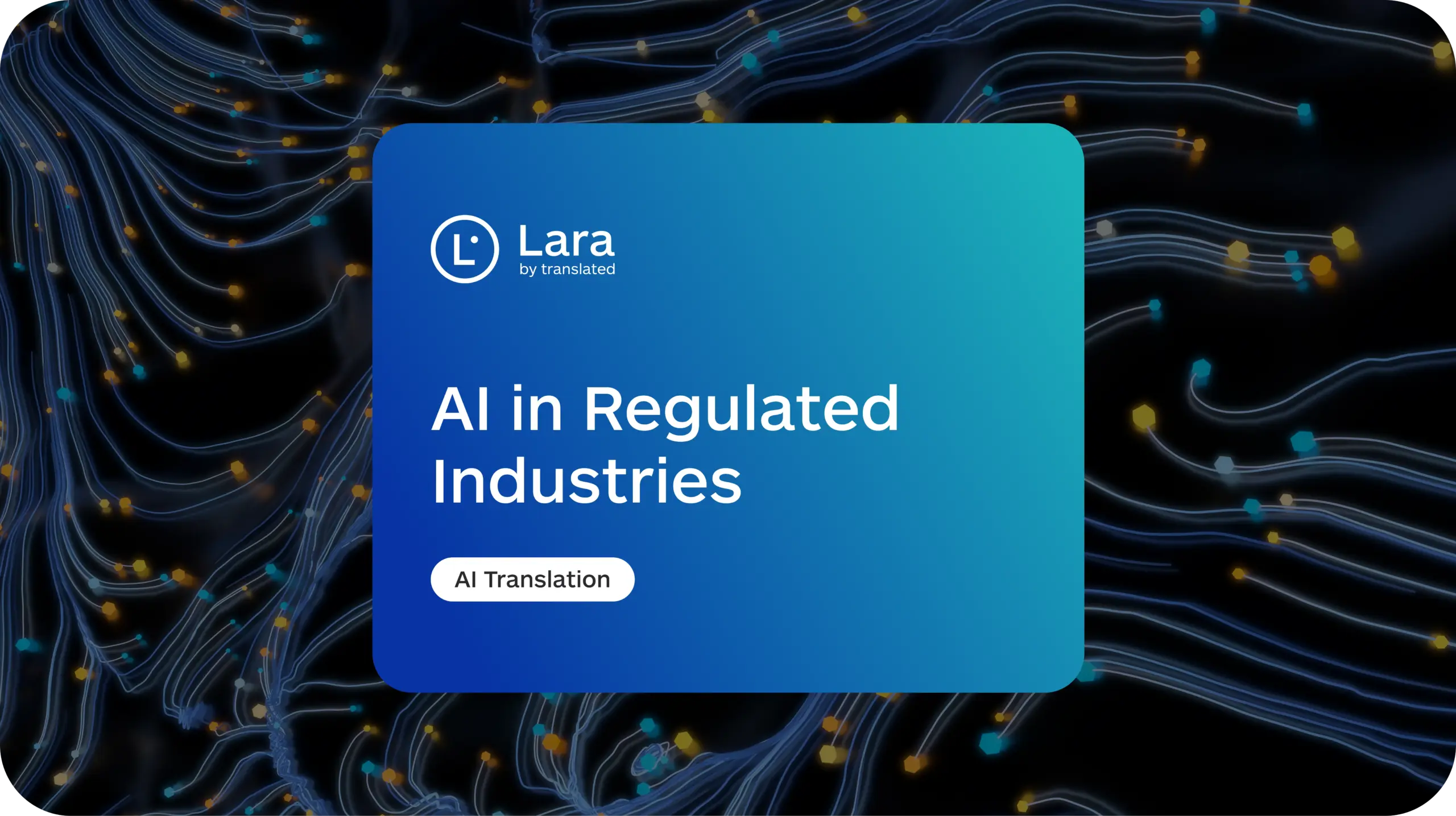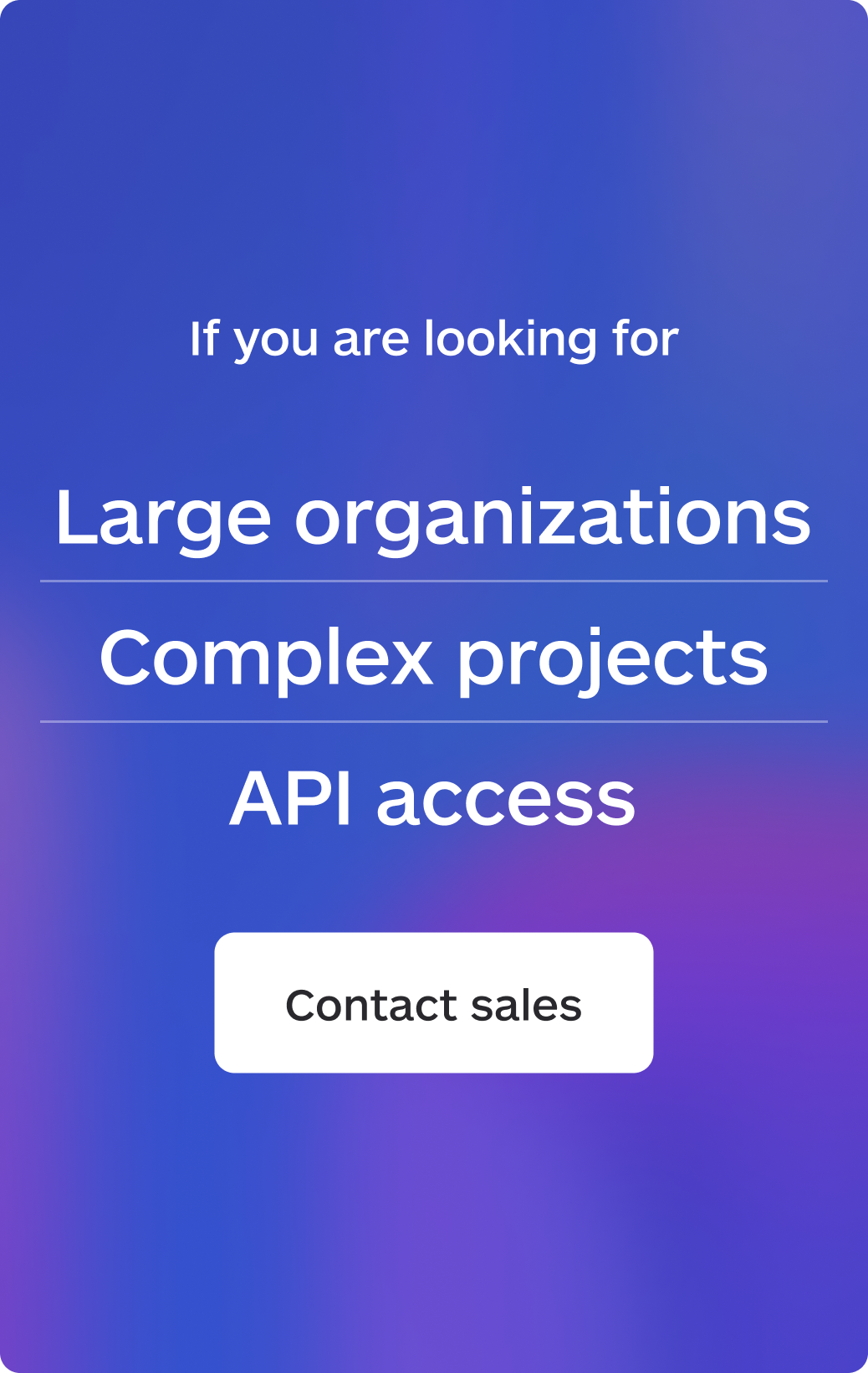AI localization with translation memories = using TMs, glossaries, and style guides to guide AI output for speed + consistency.
When businesses decide to expand globally, one of the first roadblocks they hit is translation. Not just the act of translating words, but doing it consistently, at scale, and without hemorrhaging budget or duplicating work that’s already been done.
Here’s the thing most companies miss: you’ve already created a treasure trove of localization assets. Every glossary, every translation memory entry, every style guide that took months to perfect—these aren’t just reference documents sitting in a folder somewhere. They’re the foundation for scaling AI localization with existing assets efficiently.
The challenge isn’t starting from scratch. It’s about leveraging AI localization with translation memories and glossaries you’ve built through years of human translation work, and plugging them into modern AI-powered workflows. When done right, this approach doesn’t just save time—it multiplies the value of every dollar and hour you’ve already invested in localization.
This guide walks through exactly how to turn those existing human assets into a localization engine that scales.
How to scale AI localization with existing assets
Quick answer
Feed your AI localization workflow with translation memories (TMX), glossaries (CSV/TBX), and style guides so it reuses approved language and follows brand rules. Clean and upload these assets, activate them per project, and tier human review by TM match rate. Result: consistent terminology, faster turnarounds, and lower costs.
TL;DR
|
Comparison table: Generic AI translation vs Asset-powered AI localization
| Criterion | Generic AI translation | Asset-powered AI localization |
|---|---|---|
| Inputs | Prompt + source text only | Source text + TMX, CSV/TBX glossaries, style guide |
| Terminology consistency | Variable across documents | Glossary enforced, do-not-translate respected |
| Brand tone and style | May drift between formal and casual | Style guide applied, stable tone by content type |
| Reuse of prior work | Little or none | Exact and fuzzy TM matches reused |
| Review effort | Full review on most segments | Tiered by TM match rate, lighter on high matches |
| Time to market | Unpredictable | Faster due to reuse and guided output |
| Cost per word | Flat or rising with volume | Declines as TM leverage increases |
| Risk of brand or legal errors | Higher without controls | Lower via glossary rules and locked terms |
| Governance | Ad hoc, hard to audit | Asset ownership, update cadence, approval trail |
| Best for content types | One-off drafts, low-stakes text | UI strings, KBs, product catalogs, legal, emails |
| Quality stability at scale | Inconsistent across locales | Consistent across locales and channels |
| Measurement | Limited beyond word counts | TM leverage %, cost reduction, turnaround time, QA scores |
| Setup effort | Low initial, higher downstream fixes | Initial asset audit and cleaning, lower ongoing effort |
| Tool example in practice | AI only, no assets active | Lara Translate with active TMX, shared glossaries, chosen style |
What are translation memories (TMX) and how do they work?
Most businesses approach AI localization like it’s a blank slate. They sign up for a platform, feed it content, and hope for the best. But here’s what happens: the AI produces translations that are technically correct but don’t sound like your brand. Terminology is inconsistent. Tone shifts between formal and casual. Product names get translated when they shouldn’t be.
The fix isn’t better AI—it’s better input. Your existing translation assets contain decisions that were made deliberately, often after extensive review. A glossary entry for a product name wasn’t randomly chosen; it was vetted by marketing, legal, and regional teams. A translation memory segment represents not just a translation, but an approved translation that’s been through quality checks.

Scaling AI localization with translation memories and other existing assets means providing your localization platform with the reference materials it needs to produce on-brand translations. Companies that take this approach often work toward reducing translation costs and achieving faster turnaround times compared to starting fresh.
The difference between generic AI translation and asset-powered AI translation is the difference between a first draft and a publication-ready piece.
How to use existing assets (TM, glossary, style guide) with AI
Before you can scale, you need to inventory what’s already in your possession. Most mid-size to enterprise companies have more localization assets than they realize, often scattered across departments or legacy systems.
Translation memories are your most valuable asset. These databases store every source-target segment pair that’s been professionally translated. If you’ve been working with human translators or translation agencies for any length of time, you likely have TM files sitting somewhere—probably in TMX format. These aren’t just archives; they’re reusable content for future projects.
Glossaries and termbases contain your company’s terminology decisions. Which terms should never be translated? How should you refer to specific features across languages? What’s the approved translation for industry jargon? These decisions took time and expertise to establish, and they should inform every future translation.
Style guides capture your brand voice, tone preferences, and formatting conventions. Some style guides specify whether to use formal or informal address in different languages. Others outline how to handle dates, numbers, or cultural references. This guidance is critical for maintaining consistency, especially when using previous content for translation as a foundation.
Marketing materials, previously localized campaigns, product documentation, and support content are also valuable resources. Even if they’re not stored in a formal translation memory, they represent approved language that reflects your brand. The process of scaling AI localization with existing assets begins with recognizing and organizing these resources.
How translation memories work with AI localization
Translation memories work by matching new content against previously translated segments. When you translate a user manual this year that contains paragraphs identical to last year’s version, a TM helps you avoid paying to translate the same content twice.
When combined with AI localization platforms, translation memories serve as reference databases. The platform matches incoming content against stored segments—exact matches get reused directly, while similar matches provide terminology and style guidance for new translations.
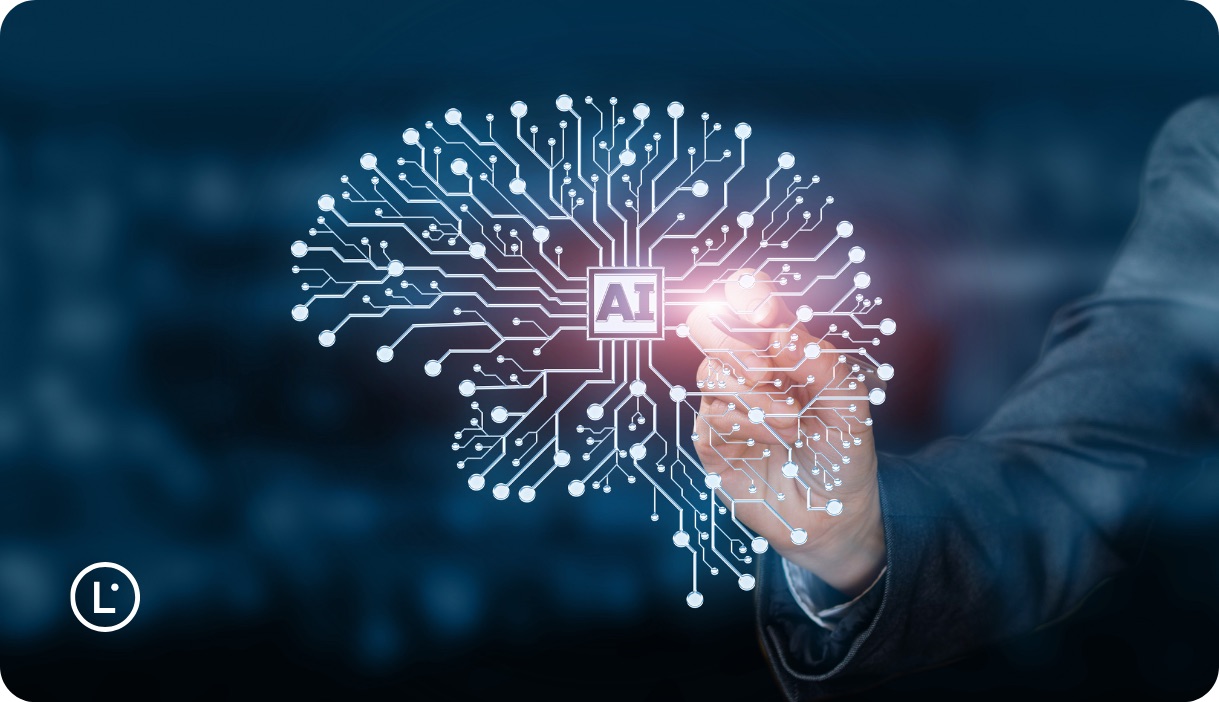
This creates a form of hybrid AI-human translation where human expertise captured in your TMs informs the platform’s output. You get speed and scalability while maintaining consistency and brand alignment.
The practical impact can be significant. A company translating a large product catalog might find that a substantial portion of segments have exact or near-exact matches in their translation memory. Those segments require minimal manual review. Another portion might be fuzzy matches that need less intervention than completely new content. This approach to scaling AI localization with existing assets demonstrates how past investments continue to deliver value across every new project.
Set-up in Lara Translate (TMs, glossaries, styles)
When it comes to practical implementation, Lara Translate is built specifically to maximize the value of assets you’ve already created. The platform supports translation memories natively, allowing you to upload and activate existing TMs directly within the interface.
If you’re on a paid Lara plan, translation memories can be linked to your account through the Support Team. For existing Translated clients, the team will associate your memories automatically. If you’re new and have TMX files from previous projects, you simply send them to Support, and they handle the setup. Once linked, you can select which translation memories to activate before starting any translation—whether you’re working with text or documents.
What makes this particularly valuable for scaling AI localization with existing assets is how Lara Translate handles the integration. The platform uses adaptive AI translation that learns from your past translations and incorporates your TMs for consistency. When a TM is active, Lara references it during translation to help align terminology and style with your previous work. If you choose not to activate a TM, Lara proceeds with its core AI capabilities alone.
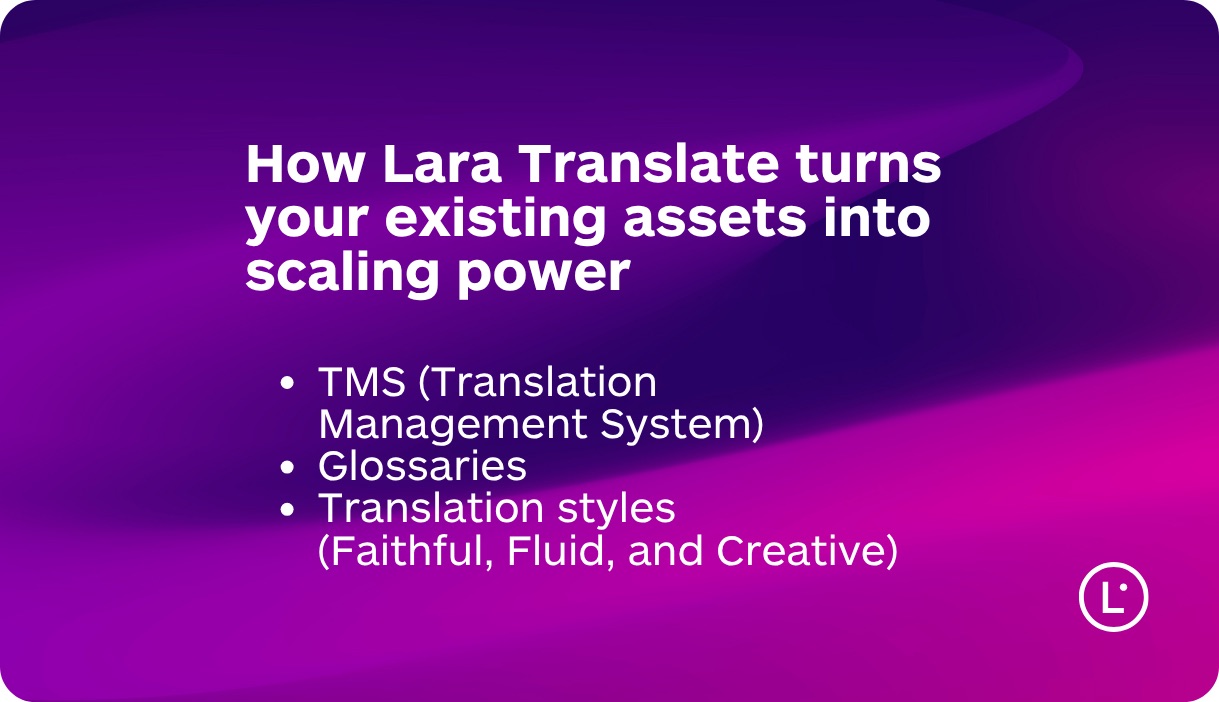
For glossaries, Lara Translate offers flexible management based on your subscription level. Pro plan users can create one glossary directly in the UI. Team plan users get unlimited glossaries and can share them across team members for collaborative workflows. Glossary entries override general AI behavior, helping to guide how specific terms are translated according to your preferences—even accounting for context like plural forms, verb tenses, and gender differences.
The glossary system in Lara Translate is unidirectional and case-insensitive, meaning entries apply from source to target language (not reversed), and capitalization doesn’t affect matching. This flexibility helps support consistent application of your preferred terminology regardless of formatting variations in source content.
Beyond TMs and glossaries, Lara Translate also offers three translation styles — Faithful, Fluid, and Creative—allowing you to adjust tone and approach based on content type. This means you can apply different styles to legal documents versus marketing materials, all while maintaining the underlying consistency provided by your linguistic assets.
For more detailed guidance on how to set up and use these features, you can explore the platform’s knowledge base and documentation.
Content reuse in localization projects: a strategic framework
The real leverage comes from thinking systematically about content reuse in localization projects. This isn’t just about plugging assets into a system—it’s about building a framework where every new translation adds value to future projects. With AI localization with translation memories, that framework turns past decisions into reusable guidance for speed and consistency.
Start by auditing your existing assets. Export translation memories from any CAT tools you’ve used previously. Gather glossaries from marketing, product, legal, and support. Collect style guides, brand voice documents, and approved localized content. Centralize everything in a format that’s accessible and standardized so AI localization with translation memories can reference the right terms and tone.
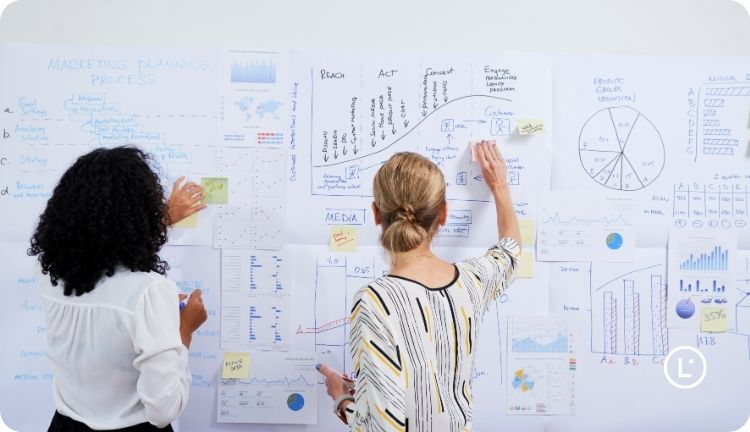
Next, establish a process for maintaining these assets. Every completed translation should feed back into your translation memory. Every new terminology decision should update your glossary. Style preferences that emerge during review should be documented in your style guide. This creates a virtuous cycle where each project strengthens the foundation for the next—key to effective AI localization with translation memories.
Set clear guidelines for when to use existing assets versus when fresh translation is needed. Highly stable content like legal disclaimers or product specifications should leverage existing TMs. Marketing content that shifts with campaigns might require more creative flexibility, but core brand terminology should still be glossary-driven within AI localization with translation memories workflows.
Create a tiered review process based on TM match rates. Segments with high TM matches might need only a quick sanity check. Lower matches require more review. New segments need full linguistic QA. This helps you allocate human review time where it has the most impact while keeping AI localization with translation memories efficient.
Companies with structured asset reuse frameworks often work toward reducing per-word translation costs over time. The key is treating scaling with AI localization with translation memories as an ongoing strategy rather than a one-time project.
Using previous content for translation without starting over
Once you’ve implemented AI localization with translation memories, you need to track whether it’s actually delivering value. The right KPIs tell you whether your existing assets are being leveraged effectively.
TM leverage rate measures what percentage of your content is being matched against translation memories. Track this to see how much of your pipeline benefits from AI localization with translation memories. If rates stay low, your TMs may need expansion or your content has shifted significantly.
Cost per word reduction should trend downward as reuse increases. Track by content type—catalogs, KBs, and UI strings typically see the strongest gains with AI localization with translation memories.
Time to market for localized content is another critical metric. If launches complete faster than before, that’s measurable impact from TM-driven reuse and lighter reviews on high-match segments.
Quality scores from linguistic QA should remain stable or improve. Properly configured glossaries and TM rules in AI localization with translation memories should reduce terminology and style errors. Rising error rates may indicate asset quality issues or misconfiguration.
Asset growth rate tracks how quickly your translation memories and glossary coverage expand. Healthy growth shows you’re capturing post-edits and new terminology decisions, fueling compounding gains from AI localization with translation memories over time.
Preparing assets for AI: technical considerations
Not all translation memories and glossaries are equally useful for AI-powered platforms. Assets created for human translators often need adaptation to work optimally with modern localization systems.
Clean your translation memories. Remove duplicate segments, outdated translations, and low-confidence entries. If your TM contains segments that were translated years ago and no longer reflect your current brand voice, either remove them or flag them for review before uploading them to your platform.
Standardize your glossaries. Make sure terminology is consistent across entries. If you have multiple glossaries from different departments that use different terms for the same concept, consolidate them. Document why specific terms were chosen—this context helps when configuring platform settings.
Format matters. While TMX is the standard format for translation memories, make sure your files are well-formed and error-free. Corrupted files or improperly encoded characters can cause issues during import. For glossaries, CSV files with clear source and target language columns are typically easiest to work with.
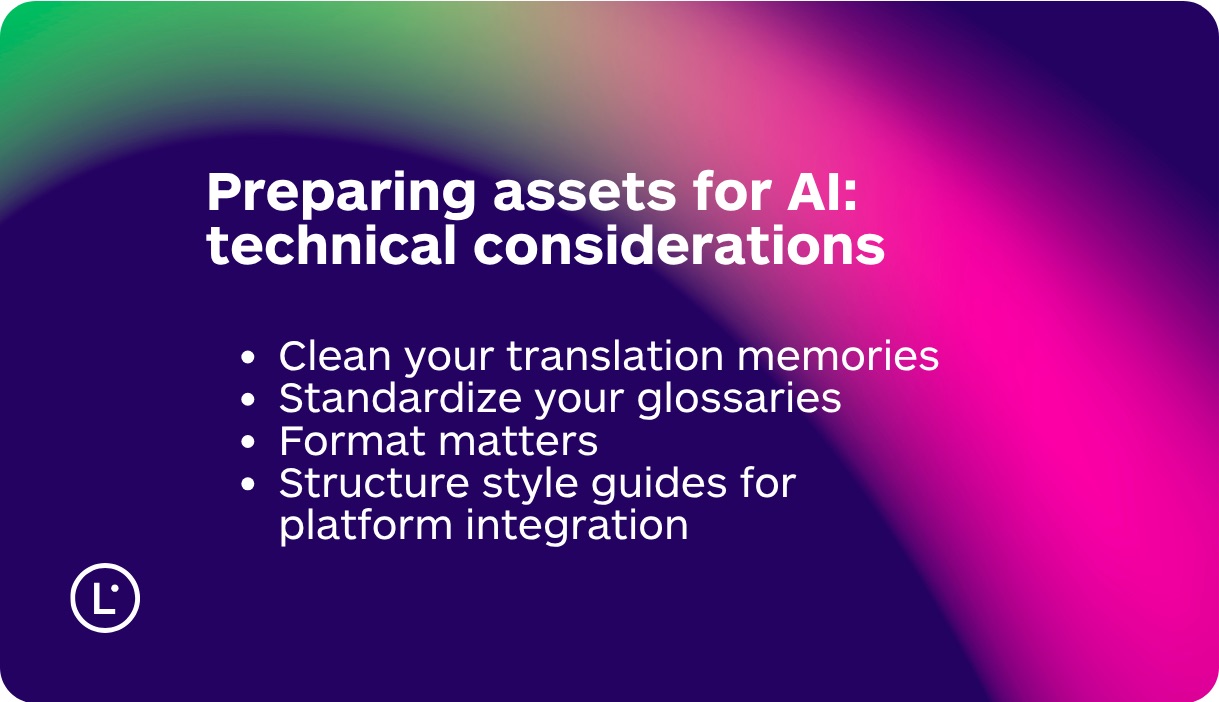
Structure style guides for platform integration. Traditional style guides written as narrative documents need to be translated into rules that localization platforms can apply. This might mean creating separate formatting guidelines, tone specifications, and do-not-translate lists that can be referenced during translation.
Organizations that invest time in asset preparation often experience fewer post-editing corrections and better results when working with AI-powered translation platforms. Proper preparation is essential for successful scaling AI localization with existing assets.
Measuring success: KPIs for asset-powered localization
Once you’ve implemented AI localization with translation memories, you need to track whether it’s actually delivering value. The right KPIs tell you whether your existing assets are being leveraged effectively.
TM leverage rate measures what percentage of your content is being matched against translation memories. Track this to see how much of your pipeline benefits from AI localization with translation memories. If rates stay low, your TMs may need expansion or your content has shifted significantly.
Cost per word reduction should trend downward as reuse increases. Track by content type—catalogs, KBs, and UI strings typically see the strongest gains with AI localization with translation memories.
Time to market for localized content is another critical metric. If launches complete faster than before, that’s measurable impact from TM-driven reuse and lighter reviews on high-match segments.
Quality scores from linguistic QA should remain stable or improve. Properly configured glossaries and TM rules in AI localization with translation memories should reduce terminology and style errors. Rising error rates may indicate asset quality issues or misconfiguration.
Asset growth rate tracks how quickly your translation memories and glossary coverage expand. Healthy growth shows you’re capturing post-edits and new terminology decisions, fueling compounding gains from AI localization with translation memories over time.
Common pitfalls & governance
Even with the best intentions, companies make predictable mistakes when trying to implement scaling AI localization with existing assets.
- Treating assets as static archives. Translation memories and glossaries aren’t “set it and forget it” resources. They require active maintenance, regular updates, and periodic audits. Outdated assets may introduce inconsistencies or obsolete terminology into new translations.
- Ignoring context. Not all translation memory matches are appropriate. A segment might be identical at the text level but require different translation based on where it appears. Good asset management includes metadata that captures context—where the segment was used, what content type it belonged to, who approved it.
- Over-relying on automation. Assets make localization platforms more effective, but they don’t eliminate the need for human review. Critical content, brand-sensitive materials, and culturally complex text still benefit from expert oversight. The goal is to use assets to reduce the volume of content requiring deep human review, not to eliminate human involvement entirely.
- Failing to train teams. If your translators and reviewers don’t understand how to work with asset-powered workflows or how to update and maintain assets, the system breaks down. Invest in training so teams know when to trust the platform output, when to override it, and how to capture new knowledge in your asset library.
- Neglecting asset governance. When multiple teams or departments create and update assets independently, you end up with fragmentation and inconsistency. Establish clear ownership, approval processes, and quality standards for all linguistic assets.
Many localization managers cite inadequate asset management as a barrier to scaling effectively, yet few have dedicated resources or tools for managing translation memories and glossaries properly.
Building a continuous improvement loop
The most successful implementations of asset-powered localization treat the system as a learning organism. Every translation project generates data that should feed back into your assets, improving future performance.
Implement a feedback mechanism where reviewers can flag when terminology doesn’t match glossary entries or when a TM match doesn’t fit the context. These flags should trigger updates to your assets—either refining terminology, adding context tags, or removing problematic segments — so AI localization with translation memories stays aligned with brand rules over time.
Track which types of content benefit most from existing assets and which require more human creativity. Look for areas with high TM leverage to prioritize AI localization with translation memories, and reserve deeper human review for net-new or creative copy.
Schedule regular asset audits: quarterly for glossaries, bi-annually for translation memories (TMX). Remove obsolete content, consolidate redundant entries, and make sure everything aligns with current brand guidelines.
Create champions within your organization who advocate for asset quality and proper maintenance. These might be senior linguists, localization managers, or translation technology specialists who understand both the technical and linguistic aspects of asset management.
Consider implementing a center of excellence (CoE) model where a centralized team manages core assets while regional teams contribute local insights and terminology. This balance between centralization and localization helps support consistency while capturing nuanced regional preferences.
The companies that excel at scaling AI localization with existing assets aren’t the ones with the most advanced technology—they’re the ones with the best processes for capturing, maintaining, and applying human knowledge through their localization workflows, with AI localization with translation memories as the backbone.
Making existing assets work harder for you
The path to efficient, scalable localization — especially AI localization with translation memories — doesn’t require you to build everything from scratch or invest in entirely new infrastructure. The assets you’ve already created—through years of careful translation work, terminology decisions, and brand voice refinement — are sitting there waiting to be activated.
Scaling AI localization with existing assets successfully means recognizing that your translation memories, glossaries, and style guides aren’t just reference materials. They’re active components of a modern localization workflow. When properly integrated with AI-powered platforms, these assets can multiply their value with every new project — this is exactly what AI localization with translation memories is designed to achieve.
The businesses that will dominate global markets in the coming years won’t necessarily be the ones with the biggest localization budgets. They’ll be the ones that learned to leverage what they already built, turning past investments into compounding returns. Teams that standardize on AI localization with translation memories turn hard-won human decisions into consistently on-brand output at scale.
Start with an honest audit of what you have. Clean it up, organize it, and plug it into a platform that knows how to use it. If you’re enabling AI localization with translation memories, that means preparing TMX files, aligning glossaries, and activating them per project. Then watch as content that used to take weeks now takes days, and costs that used to be prohibitive become manageable. That’s not just optimization—it’s transformation.
How to implement AI localization with existing assets
- Audit & centralize assets — Inventory TMX files, CSV/TBX glossaries, style guides, do-not-translate lists, approved past content. Save to a single, version-controlled location.
- Clean translation memories — Deduplicate, remove obsolete segments, fix encoding, align segmentation rules. Tag domain/locale; drop low-confidence legacy entries.
- Standardize glossaries — Merge departmental lists, resolve conflicts, mark locked/brand terms, add context (POS, gender, number), and define non-translatables.
- Operationalize style rules — Convert narrative guides into rules: tone (formal/informal), punctuation, numerals, date/time, address forms, typography, units.
- Configure in Lara Translate — Upload/activate TMX for the project; create/share glossaries (Team: unlimited); select translation style (Faithful/Fluid/Creative); set do-not-translate terms.
- Define reuse thresholds — Policy by match rate: 100%/CM (reuse), 95–99% (light edit), 85–94% (edit), <85% (full translate). Map rules by content type (UI, KB, legal, marketing).
- Tier human review — Lighter checks on high matches; full LQA on new/brand-sensitive text. Use checklists for terminology, tone, and locale-specific compliance.
- Close the loop & measure — Feed post-edits back to TM; update glossaries with new decisions; track KPIs: TM leverage %, cost per word, turnaround time, QA scores; schedule quarterly asset audits.
FAQs
How do translation memories work with AI localization platforms?
Translation memories store previously translated segments and their source text pairs. Localization platforms reference these memories during translation, reusing exact matches and using similar matches as terminology guidance. This helps maintain consistency with past work while processing new content efficiently.
Can I use glossaries from different CAT tools with AI translation?
Yes, most AI localization platforms accept standard glossary formats like CSV or TBX. You can consolidate glossaries from different CAT tools into a unified format that your platform can reference. The key is standardizing terminology and removing duplicates before import.
What’s the difference between reusing translation memories and just copying old translations?
Translation memory systems match content based on similarity. When segments are similar but not identical, the platform can use stored terminology as reference while adapting the translation to fit the new context. This creates consistency without rigidity, unlike simple copy-paste approaches.
How often should translation memories be updated?
Translation memories should be updated continuously as part of your standard workflow—every completed translation should feed back into your TM. However, formal audits to remove outdated segments should happen at least twice annually, or whenever significant brand or product changes occur.
Do I need human translators if I’m using AI with existing assets?
Yes, but in a different capacity. Human expertise remains essential for quality review, handling nuanced content, making new terminology decisions, and maintaining your linguistic assets. The role shifts from translating everything manually to guiding and quality-checking platform output while keeping assets current.
This article is about
- Scaling AI localization with existing assets by leveraging translation memories, glossaries, and style guides you’ve already created
- How leveraging translation memory and glossaries can reduce costs and accelerate multilingual project timelines
- Practical strategies for using previous content for translation without duplicating effort
- Implementing content reuse in localization projects to build efficiency at scale
- Understanding content assets localization and hybrid AI-human translation approaches for optimal quality
Have a valuable tool, resource, or insight that could enhance one of our articles? Submit your suggestion
